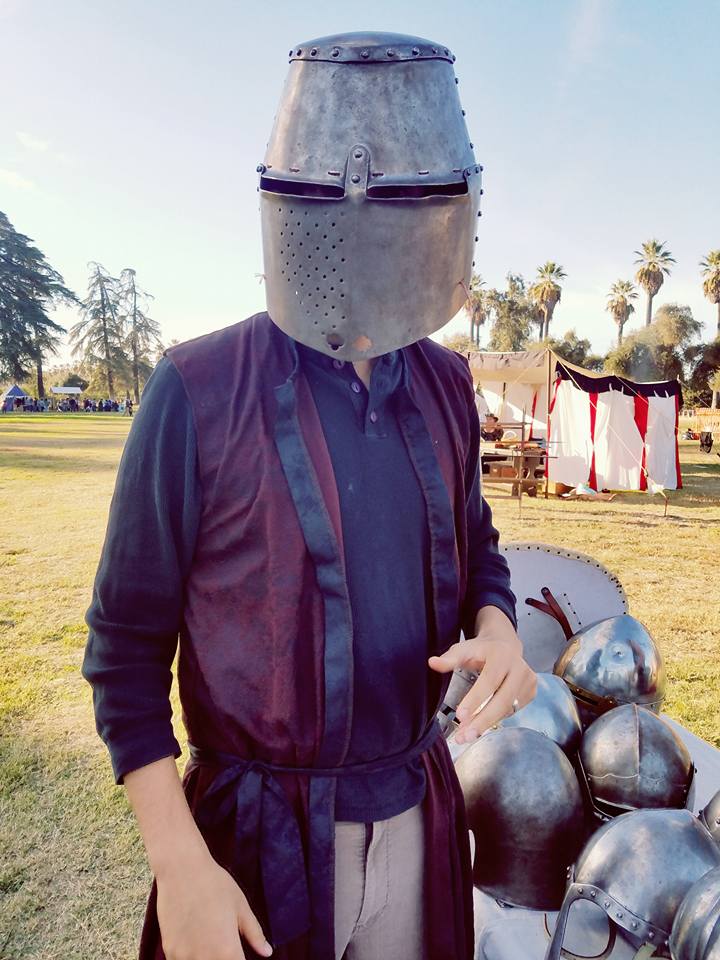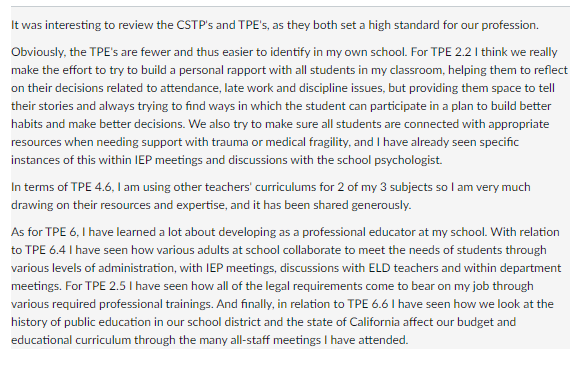About me
Hi! My name is Francisco Rendon. I am 36 years old and in 2023 I left the field of journalism and began a career in education. Prior to that I worked for a number of years as a journalist, primarily at the trade publication Pollstar. I am currently completing my teaching credentials through California State University – East Bay. When I’m not teaching I volunteer with the Junior Youth Spiritual Empowerment Program, I love to play music with friends, and I have been known to play some recreational video games.
I now teach English Language Arts for 10th and 12 graders at Chowchilla Union High School in Chowchilla, California where I have been completing my student teaching internship. A bit of demographic information: My school had 1,078 students enrolled in the 2022-23 school year. Of these students 68.8 percent were designated as Hispanic or Latino, 24.2 percent were designated as White and no other ethnic group comprised more than 2 percent of the student population. This means that 93 percent of the student body falls into these two demographics. The average class size for English Language Arts at my school has hovered around 27 over the past 3 school years and this has been true in my experience. During a normal school day I teach 6 55-minute periods with one prep period. I also teach 6 block periods of approximately 90 minutes over the course of 2 days each week. The student suspension rate at my school last year was approximately 9 percent, and the expulsion rate was under 1 percent, and in general I have had a great experience with the students. The Chronic Absenteeism rate was approximately 26 percent, and attendance has occasionally been a struggle, but in general the students are a delight. The graduation rate was approximately 92 percent last year, with a dropout rate of approximately 7 percent. Hopefully we can improve on that this year. Of these groups, the students with the highest graduation rate was students receiving migrant education services (100 percent) and the lowest was students with disabilities (78.6 percent). I have had a great experience with my administration and department teaching team and, God willing, I will have the opportunity to continue to work with them next year. My supervising teacher has been incredibly supportive and I feel fortunate to be in a situation so close to my home.

My belief on the importance of education
I truly believe that education is the means by which mankind can benefit from the many inherent treasures which each human possesses. There is so much potential in every person, but we all need love, support, encouragement, and attention to get the best out of ourselves, and I believe the classroom is a wonderful place to help young people become the best version of themselves. I believe everyone should have access to a high-quality education and I believe language and the power of expression is a very important part of that. I have already found teaching English to be very fulfilling and do not imagine myself leaving the profession anytime soon.
My approach to teaching
- I believe every student is capable of learning, although many students learn many ways. The mark of a good teacher, then, is to help all students advance in understanding, regardless of where they start in the level of understanding. Below are 3 “domains” I believe the work of teaching falls under, and this is how I approach my work and how I intend to constantly be improving.
- Building relationships is a core domain of a good educator. Learning who each student is, what their strengths and areas for improvement are, how to talk to and support them, and the family and community they belong to, is necessary to effectively educate. Once you have a relationship, the work of maintaining a healthy, welcoming and focused classroom environment is built off of this.
- The development and modification of curriculum is another core domain for educators. This encompasses lesson planning, modification, assessment, reteaching, and every element of the before and after work of teaching. This is the area that most deals with deciding what students are to learn, how they will learn it, what was effective and what needs to be done next. This is an area I have realized I have a long way to go for.
- I would call the final domain of teaching instructional techniques. This is basically a term for the mechanical work of teaching. Even if you have strong relationships with students, even if you have planned and modified excellent lesson plans, the work of getting students engaged, helping them understand and apply the subject matter, is a domain unto itself. Learning how to modify seating arrangements, how to use group/partner/individual work, using visual aides, speaking effectively, asking the right follow-up questions, there is a tool-box of tricks that has to constantly be growing. As the ways students learn is manifold, so must be our strategies for engaging them.
In addition to this basic philosophy, I do my best to honor all IEPs and 504s in my classroom, to modify lessons for students learning English as a second language and other learners with specific needs, and I generally try to create an environment in which everyone can contribute and shape the environment to everyone’s needs. I know I am still learning about how to do this, but my first year has been a wonderful experience.

Artifacts from Coursework (Fall and Spring)
This presentation for my TED-528 class taught me about how to break down different elements of poetry including rhyme, meter, and content. I include color coding to help students identify the different portions, but challenge students to try to figure things out on their own if they don’t need the scaffolding. I also provide scaffolding for the students to write their own poem in the same form. This lesson was helpful because, through it, I learned about how to use OneDrive and Microsoft’s online suite of tools for my Technology In The Classroom course.
This lesson plan for my TED-520 class was the first time I really had to think about a lesson plan as a series of planned out activities in the classroom. I found it very helpful and the skills I built through this lesson have been useful throughout the year. The lesson itself gives students the ability to choose the music they want to study in a later portion and scaffolding is provided in the form of a graphic organizer that shows students exactly what to write and where.
This infographic I created for my TED-524 course is an attempt to represent what I learned about Universal Design for Learning, a term that was previously unfamiliar to me. Many of these educational terms end up relating to each other, and I can see how accessibility and making sure the lesson plan truly is “universal” fits into the umbrella of a special education class. This lesson was part of a larger realization throughout the semester that I need to make sure I am incorporating a lot of visual elements to my lessons, as too often I tend to talk or just use words. Infographics, videos, graphic organizers all help students interact with the subject matter and I need to continuously be learning about how to use them. I also learned about the use of technology as it relates to UDL, making sure all materials are perceivable, operable, understandable and robust. I also realized that giving students agency in selecting their subject matter can increase engagement and even make learning more accessible.

This assignment for my TED-529 class forced me to reflect on the California Standards for the Teaching Profession. It was remarkable how broad the legal language is and how many things are expected of teachers. While I found many of the standards to reinforce what I had already learned in my University courses, I still was surprised at the volume of examples given. It simply isn’t reasonable to ask a person to go through a mental checklist of dozens of items every day and make sure they are doing all of them. If this isn’t how we are expected to operate, I find it difficult to understand why the standards are presented this way, but I guess this speaks to the difficulty of overseeing such an important profession.
Artifacts from Field Work
Throughout the year I was mostly using curriculum prepared by my grade-level partners or mentor teacher. However, I quickly learned that you need to make curriculum your own to teach it effectively. This was a rubric I designed for a part of their Senior Research Project, which required them to make an “infomercial” for one side of their research topic. For the better part of several months students had to research a topic by printing out and summarizing 8 articles. They also had to prepare “infomercials” or persuasive slide shows or videos that argued for both sides of the issue. Finally, they had to write a persuasive essay that effectively cited research. I learned a lot about how to teach this curriculum throughout the year, but having rubrics that I know how to explain and use proved essential as the year progressed. Students need to know what they are being evaluated on, and within this I was much better able to explain how the assignment could be modified based on their individual needs, and provide meaningful feedback on what needed to improve. This was one of those rubrics I learned to develop, based on other rubrics used by my grade level partners.
This was actually probably the first original document I created at my placement. While I inherited curriculum for my general education class, I was mostly given Carte Blanche for the Creative Writing elective class I had throughout the year. This syllabus incorporated language from other syllabi from my grade level partners, but a lot of it was my own ideas about how the class would be structured and operate. It really shows how I am trying to make the class enjoyable for both experienced and novice writers, and am giving credit to everyone who is willing to make the effort to write. I explain the different opportunities people will have to try different media, the flexibility within the curriculum and the support available for them. I am very pleased with how the class went through the year and am overall proud of how this turned out, considering how much I did not know at the time.
Throughout the year I had my students do research projects in Kagan groups at different points during each semester. These projects would usually require students to fill out a research document, to prepare some creative work (which could be a drawing, poem, story, video, or something else) and to present to the class about what they learned. Many students responded well to the research topic of video games during our study of the novel Ready Player One. It was interesting to see how some students really excelled in their ability to present or produce creative works expressing their research. I have learned a lot about how to use Kagan groups and will likely keep these as an element of my curriculum moving forward. Attached is the research document students were required to fill out, modeled after a template provided by a colleague.